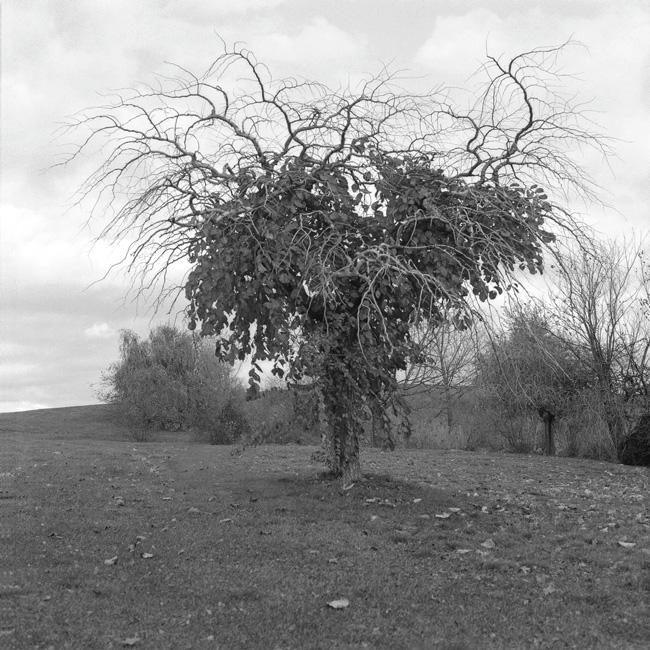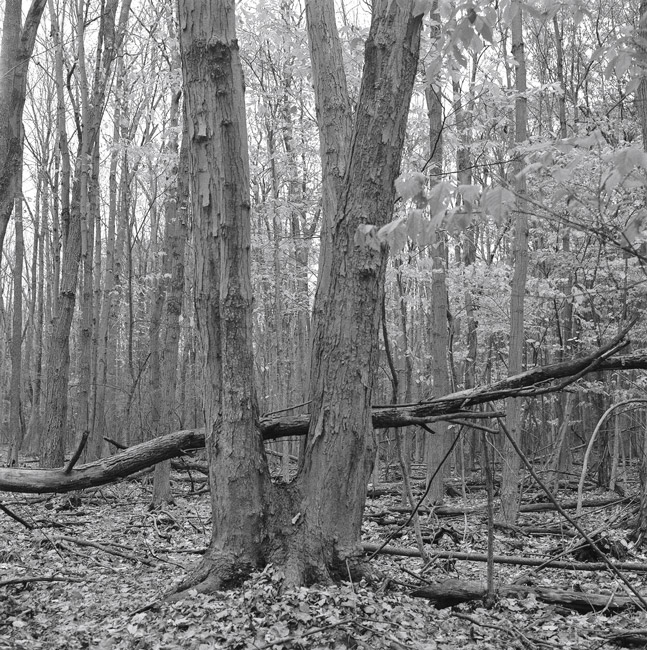[Spring-Summer 2018]
木 – A tree
Galerie d’Este, Montréal
November 15–December 10, 2017
By John K. Grande
Masako Miyazaki’s photography show titled A Tree complements her poetry. Some of the images were made in forests, fields, and landscapes on Montreal’s south shore, and others were made in Japan. Whether in Japan or Quebec, the landscape remains Miyazaki’s constant point of reference. Miyazaki’s latest show, manifesting her ongoing dialogue with nature, involves near-anthropomorphized images of trees in stark contrasts. In her photograph Beyond Time (2017), for instance, we see an incredible tangle, swirl, and whirl of tree roots. In her photo book The Other Side (Tokyo: Tosei sha, 2011), she comments, “Through photography, perhaps, I scoop and collect my floating self and make a connection between ‘this side’ and ‘the other side.’” In the latest images at Galerie d’Este, with their symbolic three-dimensional nature forms in space, we sense the private world that she refers to – a world of conjecture, association, and imagination. A small but strong gelatin-silver print from an earlier period, Dream (2008), builds on the textures and contrasts of a series of pods or berries on a branch. Japanese traditions – illustrations by Japan’s Ukiyo-E woodcut artists such as Hiroshige and Hokusai – surface here. Nature tells a story.Nature is less object than pretext for interactive flection and action vis-à-vis the culture-nature paradigm. For these early black-and-white works, Miyazaki mixed the chemicals and printed the works at her home studio in Japan.
The scale of all of Miyazaki’s photographs is human. There is no distortion or manipulation of the images, no colourizing or shading. The physical, tactile experience remains a point of reference. These works develop an eco-aesthetic that is less about scale or distancing from nature, and more about connectivity to nature. This longstanding tradition includes the Japanese garden, for instance, which, like Miyazaki’s walks through nature, is an interactive yet planned sensory and emotional aesthetic event. The poetry that Miyazaki writes, she says, follows up from the photography and is written later on, after she senses the photographs and the scenes that she captures.
Miyazaki’s earlier project Green Hole, also on view, evolved into a portfolio with a poem that has a dream-like sense of time’s passages. Green Hole was partly inspired by astronomical black holes; as Miyazaki says, “I feel these points of energy in nature, like black holes.”
One of the most striking images in the Galerie d’Este show is of a landscape in Japan. The tree to the right has stark, bold outlining, its sinuosity a paraphrase for human feelings, reminiscent of Edvard Munch’s paintings of nature. We feel no distance or separation from this natural scene.
The foggy background is near-cinematic and provides a context and environment for the animated tree to project against and contrast with. One theatrical element – a tree – comes alive as form in nature. Nature is both the subject and the backdrop – it’s all nature. Backgrounds and environments become almost like involuntary screens in these photographs. Sometimes out of focus, they reference our innermost primordial (sometimes unconscious, other times conscious) identification with nature. The foregrounds are animated, highlighted. Although Miyazaki has innovated with inkjet printing for many of the recent works, the images are unaltered, unmanipulated, and embody a straight photographic tradition. What she captures is what the image consists of, pure and simple.
Song of Clematis (2017) seems layered and textured due to the Japanese Washi photographic paper used, which gives it a watercolour quality. The sense is impressionistic, like a Monet painting. Firefly (2016) again reifies the sense of a moment, due to the time-exposed forms that hover and blur, and the firefly itself is a yellow spot in the centre of the composition. We get a sense of depth, immeasurable and infinite, in this work. The sensibility is strangely, slightly out of this world. These photographs, because they are in the scale of life, reify experience, bring it to life.
John K. Grande is a freelance curator, writer, and poet. His most recent shows include Small Gestures for the Mucsarnok/ Kunsthalle in Budapest (2016) and the International Painters’ Symposium, Oaxaca, Mexico (2017). His latest publications are In) Formation – Alice Techert Recent Paintings (Munich: Hirmer Verlag, 2017) and Nadalian (Tehran, 2017).
[ Numéro complet, en version papier et numérique, disponible ici : Ciel variable 109 – REVISITER ]
[ Article individuel, en numérique, disponible ici : Masako Miyazaki, 木 – A tree – John K. Grande ]



